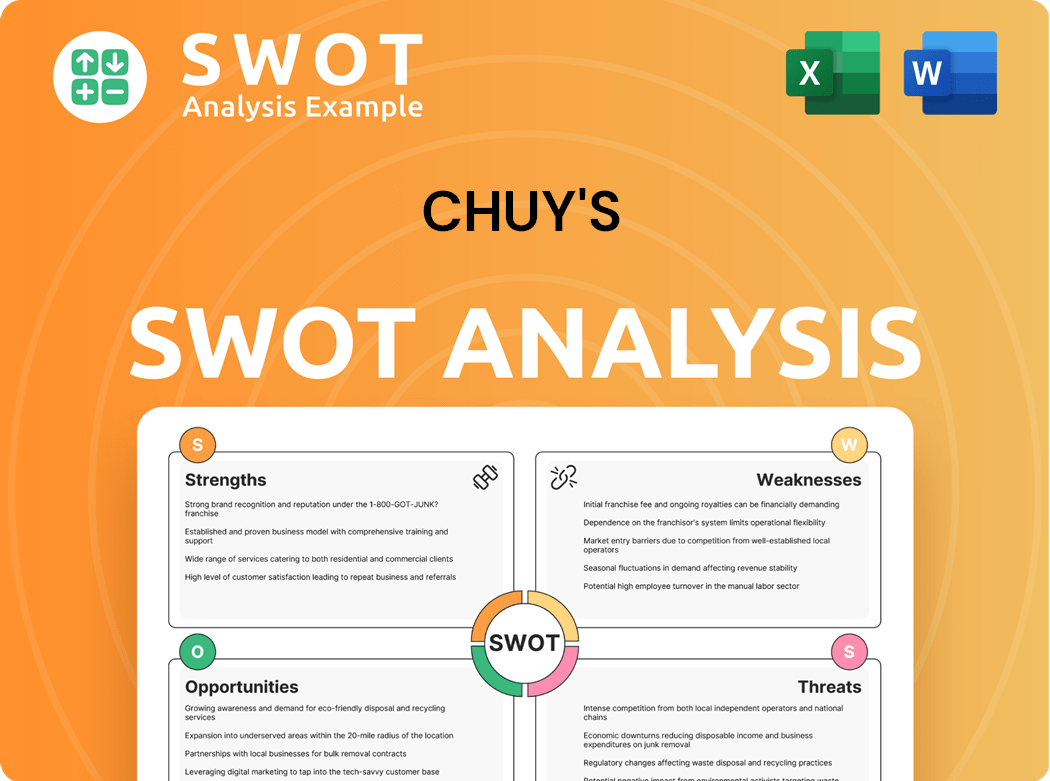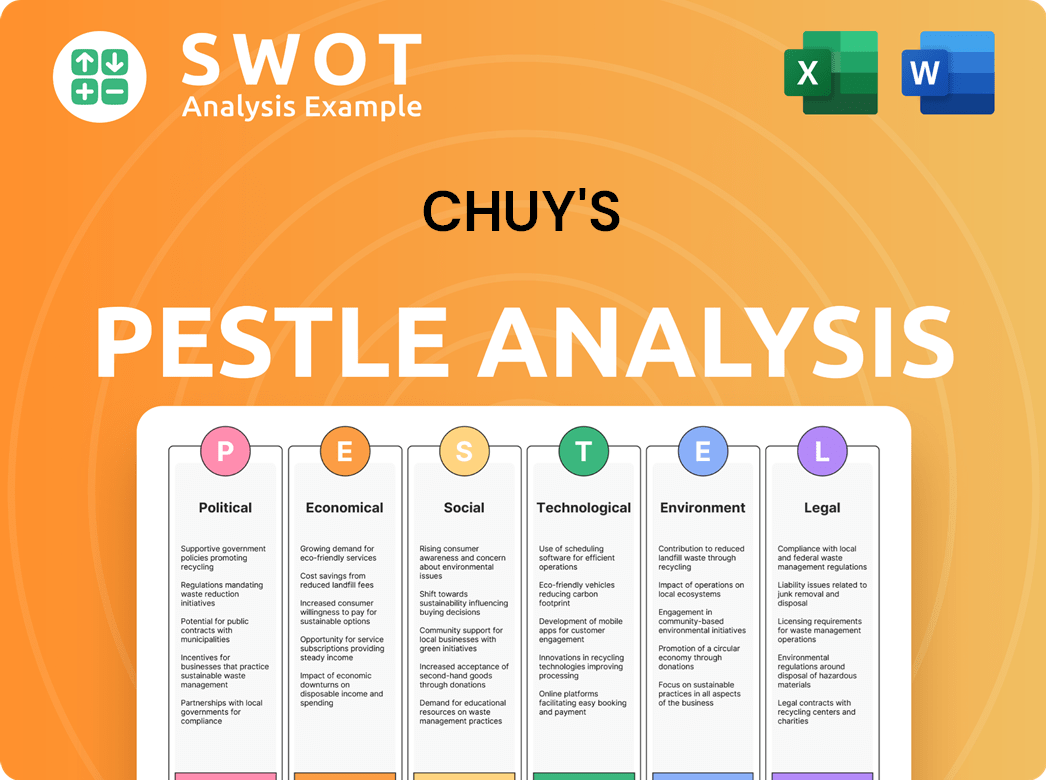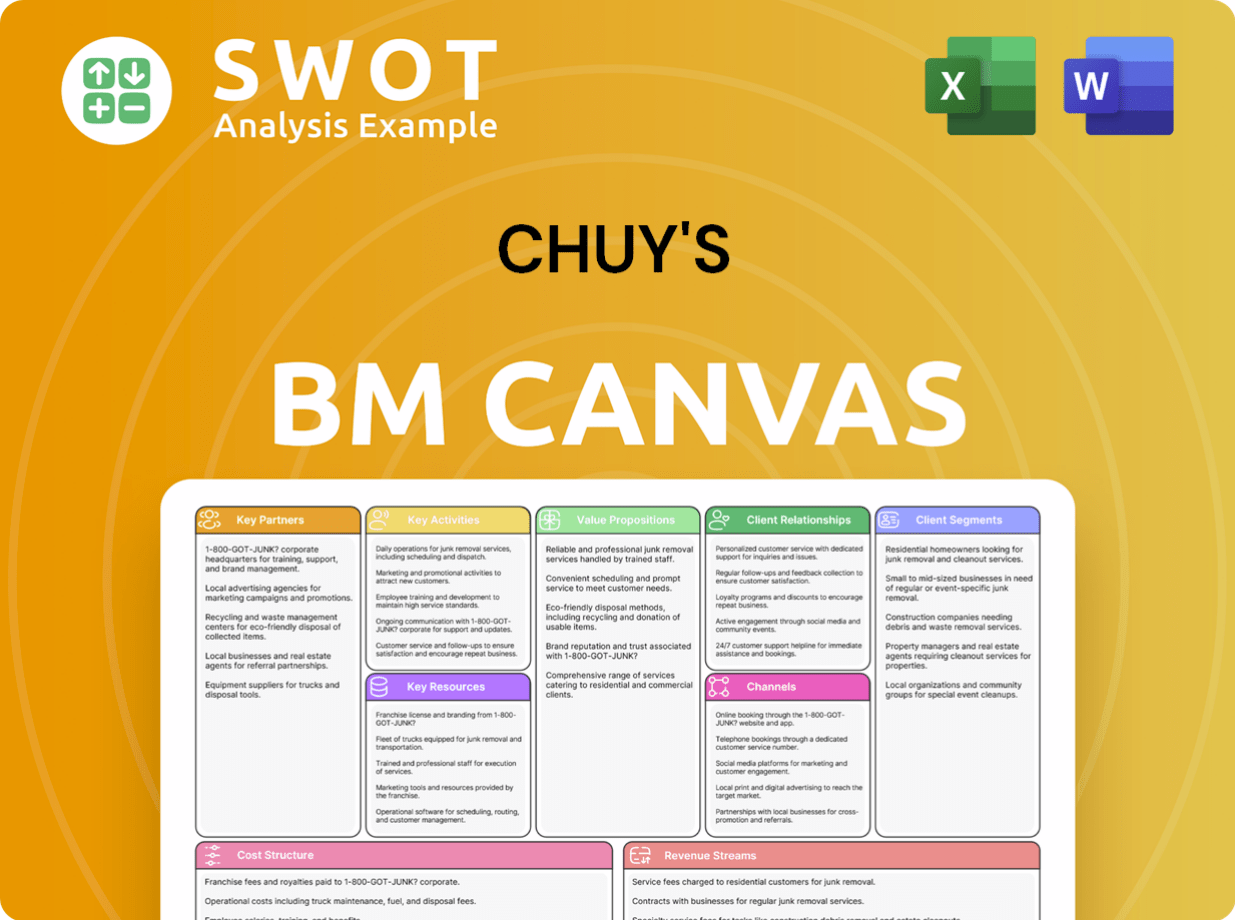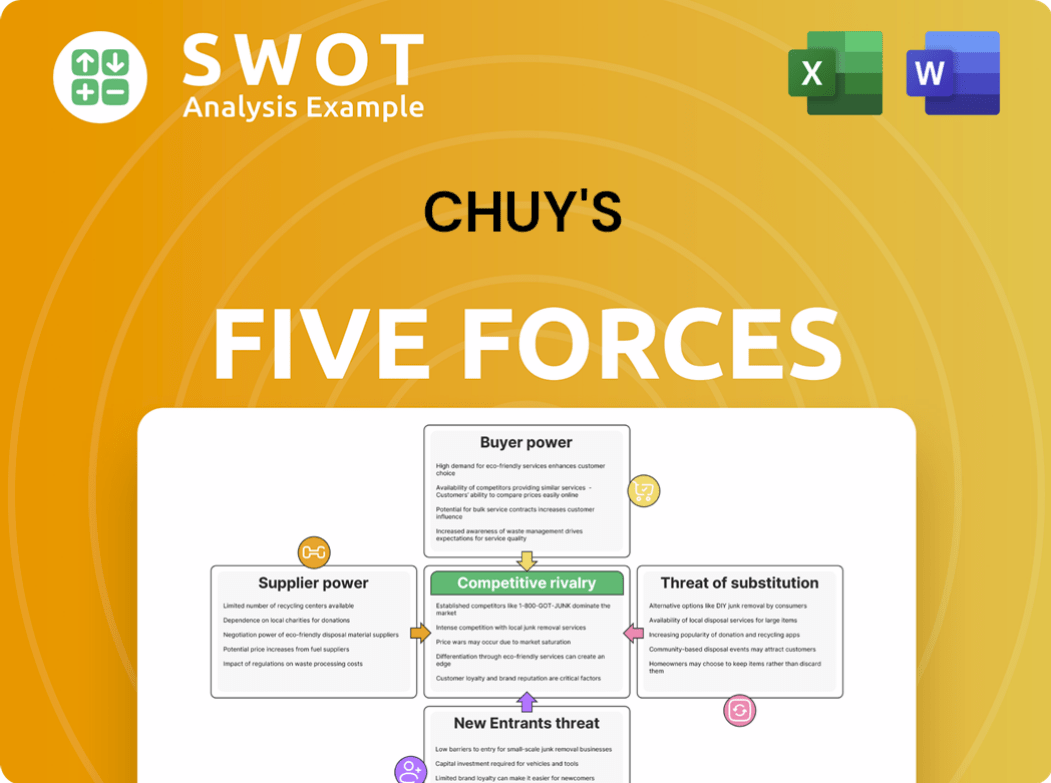Chuy's Bundle
Can Chuy's Thrive in the Tex-Mex Restaurant Arena?
In the sizzling world of casual dining, Chuy's Holdings, Inc. brings a vibrant Tex-Mex experience to the table, but how does it stack up against its rivals? Founded in Austin, Texas, Chuy's has cultivated a unique brand centered on fresh ingredients and a fun atmosphere. From its humble beginnings in 1982, the company has expanded, becoming a notable player in the competitive restaurant industry.

To understand Chuy's position, we'll dive deep into its Chuy's SWOT Analysis and the broader Chuy's competitive landscape, examining Chuy's competitors and Chuy's market analysis. This exploration will reveal Chuy's business strategy and its ability to navigate the ever-changing Tex-Mex restaurant industry, providing insights into its strengths, weaknesses, and future prospects. We'll also address questions like: Who are Chuy's main rivals; How does Chuy's differentiate itself from its rivals; What are the key success factors for Chuy's in the market; and How has Chuy's adapted to changing consumer preferences?
Where Does Chuy's’ Stand in the Current Market?
Chuy's Holdings, Inc. carves out its niche within the casual dining sector, specifically focusing on Tex-Mex cuisine. The Marketing Strategy of Chuy's emphasizes a fun, quirky atmosphere paired with value-oriented pricing. The company's core offerings include a diverse menu of Tex-Mex dishes, such as enchiladas, burritos, and fajitas, all prepared with fresh ingredients.
As of late 2024, Chuy's operates over 90 restaurants across 17 states, primarily in the Southeast and Southwest United States. This positions the company as a notable player in the Tex-Mex restaurant industry. Its customer base primarily comprises families, young adults, and casual diners who seek a lively environment and flavorful Tex-Mex food.
Chuy's maintains a consistent focus on delivering a unique dining experience, avoiding shifts into premium or budget markets. The company reported total revenue of $443.9 million for the fiscal year 2023, up from $428.1 million in 2022, and a net income of $26.8 million, or $1.04 per diluted share. Its average unit volumes (AUV) for 2023 were about $4.9 million.
Chuy's holds a distinct market position specializing in Tex-Mex cuisine within the casual dining segment. The company emphasizes fresh ingredients and made-from-scratch preparation in its menu. Its operational footprint includes over 90 restaurants across 17 states, primarily in the Southeast and Southwest United States.
Chuy's primarily targets families, young adults, and casual diners. These customer segments are attracted to the vibrant atmosphere and flavorful Tex-Mex fare. The restaurant's value-oriented pricing and unique dining experience further appeal to its target demographics.
Chuy's reported total revenue of $443.9 million for fiscal year 2023, an increase from $428.1 million in 2022. Net income for 2023 was $26.8 million, or $1.04 per diluted share. The company's average unit volumes (AUV) for 2023 were approximately $4.9 million.
Chuy's has a strong presence in Texas and other Southern states, where Tex-Mex cuisine is popular. Its market position may be weaker in regions where Tex-Mex is less prevalent or where strong local competitors dominate. Expansion strategies are key to its competitive landscape.
Chuy's competitive advantages include its unique brand identity, value-oriented pricing, and focus on fresh, made-from-scratch ingredients. Its strong presence in key markets like Texas and its ability to maintain a consistent dining experience contribute to its success. Analyzing the Chuy's competitive landscape reveals several factors.
- Strong Brand Identity: A fun, quirky atmosphere.
- Value-Oriented Pricing: Appealing to a broad customer base.
- Fresh Ingredients: Emphasis on made-from-scratch preparation.
- Strategic Geographic Focus: Strong presence in Texas and Southern states.
Chuy's SWOT Analysis
- Complete SWOT Breakdown
- Fully Customizable
- Editable in Excel & Word
- Professional Formatting
- Investor-Ready Format

Who Are the Main Competitors Challenging Chuy's?
The competitive landscape for Chuy's in the Tex-Mex restaurant industry is dynamic, shaped by a mix of direct and indirect competitors. Understanding these rivals is crucial for analyzing Chuy's market position and future prospects. This analysis helps decision-makers assess Chuy's business strategy and identify opportunities for growth and differentiation.
Chuy's faces competition from various types of restaurants. These competitors employ different strategies to attract customers and maintain market share. This competitive pressure influences Chuy's operational and strategic decisions, impacting its financial performance and expansion plans.
Chuy's operates in a highly competitive casual dining market, facing both direct and indirect competition. Its most significant direct competitors in the Tex-Mex and Mexican casual dining space include chains like On The Border Mexican Grill & Cantina, founded in 1982, which offers a similar full-service Tex-Mex experience with a broader menu and larger footprint. Another direct competitor is Uncle Julio's, known for its 'made-from-scratch' approach and upscale casual dining experience. Regional chains like Pappasito's Cantina, particularly strong in Texas, also pose a significant challenge due to their established brand loyalty and extensive menus.
Direct competitors offer similar Tex-Mex and Mexican casual dining experiences.
Key players include On The Border, Uncle Julio's, and regional chains like Pappasito's Cantina.
Indirect competitors compete for the same customer dollars with different dining experiences.
This includes casual dining restaurants like Chili's and Applebee's, and fast-casual Mexican concepts like Chipotle and Qdoba.
Competitors use various strategies to gain market share.
On The Border leverages scale and promotions, while Uncle Julio's focuses on a premium experience.
Mergers and acquisitions can reshape the competitive landscape.
Emerging players and niche cuisines add to the competitive dynamics.
Indirect competitors include a wider array of casual dining restaurants that compete for the same diner dollars, such as Chili's Grill & Bar and Applebee's, which offer a diverse menu including some Tex-Mex inspired items. Fast-casual Mexican concepts like Chipotle Mexican Grill and Qdoba Mexican Eats also indirectly compete by offering quick, customizable Mexican food options, appealing to a different, often faster-paced, customer segment. These fast-casual players challenge Chuy's by offering convenience and often lower price points.
The competitive landscape in the Tex-Mex restaurant industry is influenced by several factors.
- Scale and Promotions: On The Border uses its larger scale and promotional activities to attract customers.
- Premium Experience: Uncle Julio's differentiates itself with a premium dining experience and unique offerings.
- Emerging Players: New restaurants focusing on experiential dining or niche cuisines can disrupt the market.
- Industry Consolidation: Mergers and acquisitions can create larger, more diversified restaurant groups.
Competitors challenge Chuy's through various strategies. On The Border, for example, leverages its larger scale and aggressive promotional activities. Uncle Julio's competes on a more premium experience and unique offerings like its 'Chocolate Piñata.' Emerging players in the broader casual dining landscape, particularly those focusing on unique experiential dining or niche cuisines, could also disrupt the traditional competitive dynamics. Mergers and alliances within the restaurant industry, such as larger holding companies acquiring smaller chains, could also alter the competitive landscape by creating more formidable, diversified restaurant groups.
Chuy's PESTLE Analysis
- Covers All 6 PESTLE Categories
- No Research Needed – Save Hours of Work
- Built by Experts, Trusted by Consultants
- Instant Download, Ready to Use
- 100% Editable, Fully Customizable

What Gives Chuy's a Competitive Edge Over Its Rivals?
Understanding the competitive landscape of a restaurant involves assessing its strengths and weaknesses relative to its rivals. For Chuy's Growth Strategy, several factors contribute to its competitive advantages within the Tex-Mex restaurant industry. These advantages are crucial for its market positioning and sustained success. A thorough Chuy's market analysis reveals how these strengths help it stand out against its competitors.
One of the primary strengths of Chuy's is its strong brand identity. The company has cultivated a unique atmosphere that sets it apart from more generic Tex-Mex establishments. This quirky and fun environment, filled with eclectic decor, creates a memorable customer experience. This, in turn, fosters customer loyalty and repeat visits, which is a key factor in the restaurant competition.
Another key advantage is its commitment to fresh ingredients and made-from-scratch food preparation. Chuy's prepares many menu items daily, including sauces and tortillas. This dedication to quality and freshness differentiates it from competitors that may rely on pre-made components. This focus on quality contributes to a superior taste profile, which resonates with customers and supports its business strategy.
Chuy's has built a strong brand identity through its distinctive decor and atmosphere, creating a memorable dining experience. This quirky environment fosters customer loyalty and differentiates it from competitors. The unique brand identity is a significant factor in its market share compared to competitors.
The emphasis on fresh ingredients and made-from-scratch food preparation is a key differentiator. Daily preparation of sauces and tortillas enhances the taste profile and quality. This commitment to freshness helps Chuy's stand out in the Tex-Mex restaurant industry.
Chuy's benefits from a strong company culture focused on hospitality and a fun work environment. This culture can lead to better customer service and employee retention. This is a key factor in the restaurant competition.
The hub-and-spoke model for fresh ingredient delivery supports its commitment to quality. This allows for greater control over food quality and consistency. The company leverages these advantages in its marketing by highlighting its unique atmosphere and 'fresh as hell' food philosophy.
Chuy's competitive advantages include brand equity, fresh food preparation, and a strong company culture. These elements contribute to its success in the Tex-Mex restaurant industry. The company's ability to maintain these advantages is crucial for its long-term performance.
- Brand Differentiation: Chuy's unique decor and atmosphere create a memorable experience, differentiating it from competitors.
- Quality Focus: The commitment to fresh ingredients and made-from-scratch food preparation ensures superior taste.
- Operational Efficiency: The hub-and-spoke distribution model supports the commitment to fresh ingredients and quality.
- Customer Loyalty: The strong brand and quality food foster customer loyalty and repeat visits.
Chuy's Business Model Canvas
- Complete 9-Block Business Model Canvas
- Effortlessly Communicate Your Business Strategy
- Investor-Ready BMC Format
- 100% Editable and Customizable
- Clear and Structured Layout

What Industry Trends Are Reshaping Chuy's’s Competitive Landscape?
The casual dining sector is currently navigating a dynamic landscape, influenced significantly by technological advancements, evolving consumer preferences, and regulatory changes. These factors create both challenges and opportunities for businesses like Chuy's. Understanding these trends is crucial for assessing the company's competitive position and future prospects. The Brief History of Chuy's provides context for its evolution within the Tex-Mex restaurant industry.
The Chuy's competitive landscape is shaped by the need to adapt to digital integration, manage rising costs, and meet changing consumer demands. Success depends on strategic responses to these challenges and opportunities. The company's ability to maintain its core brand identity while embracing innovation will be critical to its long-term success.
The Tex-Mex restaurant industry is seeing a surge in online ordering and delivery services, with digital loyalty programs becoming increasingly vital. Customers are seeking convenience and personalized experiences. Healthier menu options and plant-based choices are also gaining traction. Regulatory changes, including labor costs and food safety, impact operational expenses.
Chuy's competitors include ghost kitchens and virtual brands, which can operate with lower overheads, intensifying restaurant competition. Rising food and labor costs could squeeze profit margins. The need for digital integration requires continuous investment in online platforms and loyalty programs. Maintaining a competitive edge requires efficient supply chain management.
Chuy's business strategy can focus on expanding off-premise dining options, such as takeout and delivery, to capture a larger market share. Menu innovation, including plant-based options, can attract new customers. Strategic partnerships with delivery services and technology providers can boost its digital footprint. Entering new markets where Tex-Mex is popular offers growth potential.
To adapt, Chuy's should leverage its strong brand identity to create differentiated loyalty programs. The company must focus on digital transformation and menu innovation to remain resilient. The company's ability to adapt to these trends, will be critical to maintaining its competitive position.
The future outlook for Chuy's depends on several key factors. To thrive in the Chuy's competitive landscape, the company must focus on customer loyalty and efficient operations. Strategic marketing and expansion are also important. Chuy's market analysis suggests that the company's ability to adapt to changing consumer preferences is crucial.
- Focus on digital platforms and online ordering systems.
- Develop and promote healthier menu options.
- Expand off-premise dining options.
- Manage costs through efficient supply chain and labor optimization.
Chuy's Porter's Five Forces Analysis
- Covers All 5 Competitive Forces in Detail
- Structured for Consultants, Students, and Founders
- 100% Editable in Microsoft Word & Excel
- Instant Digital Download – Use Immediately
- Compatible with Mac & PC – Fully Unlocked

Related Blogs
- What are Mission Vision & Core Values of Chuy's Company?
- What is Growth Strategy and Future Prospects of Chuy's Company?
- How Does Chuy's Company Work?
- What is Sales and Marketing Strategy of Chuy's Company?
- What is Brief History of Chuy's Company?
- Who Owns Chuy's Company?
- What is Customer Demographics and Target Market of Chuy's Company?
Disclaimer
All information, articles, and product details provided on this website are for general informational and educational purposes only. We do not claim any ownership over, nor do we intend to infringe upon, any trademarks, copyrights, logos, brand names, or other intellectual property mentioned or depicted on this site. Such intellectual property remains the property of its respective owners, and any references here are made solely for identification or informational purposes, without implying any affiliation, endorsement, or partnership.
We make no representations or warranties, express or implied, regarding the accuracy, completeness, or suitability of any content or products presented. Nothing on this website should be construed as legal, tax, investment, financial, medical, or other professional advice. In addition, no part of this site—including articles or product references—constitutes a solicitation, recommendation, endorsement, advertisement, or offer to buy or sell any securities, franchises, or other financial instruments, particularly in jurisdictions where such activity would be unlawful.
All content is of a general nature and may not address the specific circumstances of any individual or entity. It is not a substitute for professional advice or services. Any actions you take based on the information provided here are strictly at your own risk. You accept full responsibility for any decisions or outcomes arising from your use of this website and agree to release us from any liability in connection with your use of, or reliance upon, the content or products found herein.